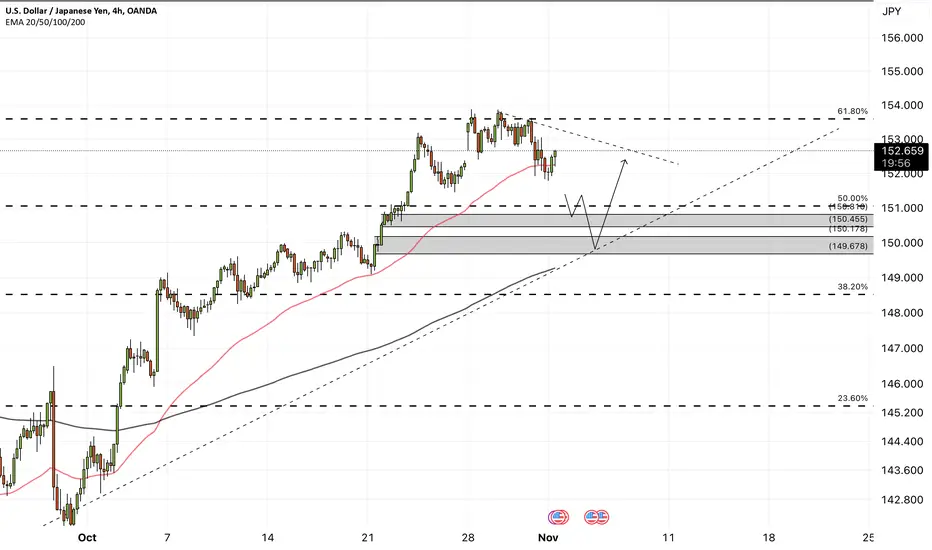The USDJPY currency pair is above the EMA200 and EMA50 in the 4H timeframe and is moving in its medium-term bullish channel. In case of correction due to the release of today's economic data, we can see the demand zone and buy in those two zones with the appropriate risk reward.
Yesterday, the Bank of Japan kept its interest rate unchanged at 0.25%, as expected. The Japanese government maintained its overall economic assessment for October, continuing to believe that the economy is recovering at a moderate pace. However, it downgraded its outlook on production, indicating that output might be facing challenges and may struggle to grow significantly.
Meanwhile, Japan’s Economy Minister, Akazawa, stated that currency movements are being closely monitored, and proposed policies from other parties will be reviewed. He also noted that a weaker yen could lead to a decrease in income and private consumption, particularly if wage growth is insufficient.
According to a recent Reuters survey of economists, 103 out of 111 economists expect the Federal Reserve to cut interest rates by 0.25% in November and December of this year, bringing the rate to a range of 4.25% to 4.5%. Additionally, 74 out of 96 surveyed economists predict that the Federal Reserve’s interest rate will drop to 3% to 3.25% or higher by the end of 2025.
A recent report from CIBC suggests that a 3% growth in U.S. GDP is unlikely to overheat the economy. CIBC believes that the U.S. economy can sustain growth at this rate while continuing its rate-cutting cycle.
The report shows that U.S. economic growth has reached 2.8%, slightly below analysts’ 3% expectation. Nonetheless, the details reflect a robust economic performance, with domestic consumption offsetting the negative effects of net trade.
CIBC analysts argue that 3% growth should be seen as a new measure of economic capacity rather than a sign of overheating. They point to improvements in productivity and cooling labor markets and inflation, asserting that
Yesterday, the Bank of Japan kept its interest rate unchanged at 0.25%, as expected. The Japanese government maintained its overall economic assessment for October, continuing to believe that the economy is recovering at a moderate pace. However, it downgraded its outlook on production, indicating that output might be facing challenges and may struggle to grow significantly.
Meanwhile, Japan’s Economy Minister, Akazawa, stated that currency movements are being closely monitored, and proposed policies from other parties will be reviewed. He also noted that a weaker yen could lead to a decrease in income and private consumption, particularly if wage growth is insufficient.
According to a recent Reuters survey of economists, 103 out of 111 economists expect the Federal Reserve to cut interest rates by 0.25% in November and December of this year, bringing the rate to a range of 4.25% to 4.5%. Additionally, 74 out of 96 surveyed economists predict that the Federal Reserve’s interest rate will drop to 3% to 3.25% or higher by the end of 2025.
A recent report from CIBC suggests that a 3% growth in U.S. GDP is unlikely to overheat the economy. CIBC believes that the U.S. economy can sustain growth at this rate while continuing its rate-cutting cycle.
The report shows that U.S. economic growth has reached 2.8%, slightly below analysts’ 3% expectation. Nonetheless, the details reflect a robust economic performance, with domestic consumption offsetting the negative effects of net trade.
CIBC analysts argue that 3% growth should be seen as a new measure of economic capacity rather than a sign of overheating. They point to improvements in productivity and cooling labor markets and inflation, asserting that
Disclaimer
The information and publications are not meant to be, and do not constitute, financial, investment, trading, or other types of advice or recommendations supplied or endorsed by TradingView. Read more in the Terms of Use.
Disclaimer
The information and publications are not meant to be, and do not constitute, financial, investment, trading, or other types of advice or recommendations supplied or endorsed by TradingView. Read more in the Terms of Use.
